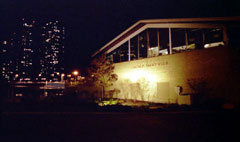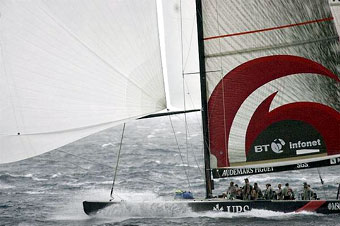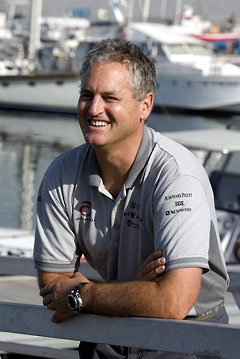|
Road Works:
Alinghi in Chicago December 2005 |
||||||||||||||||||||
Ed Baird and Hamish Ross stopped in Chicago on their recent US visit. At the Chicago Yacht Clubís Belmont Harbor station, Ed and Hamish treated an enthusiastic group of young sailors from the clubís junior ranks to an inside look at Alinghi, and the challenges and rewards of being an Americaís Cup sailor. Against a backdrop of skyscrapers and the seasonís first snow flakes, Ed Baird talked training, racing, and winning to the juniors while Hamish Ross filled in some interesting facets of Americaís Cup history and the modern format of the Cup. For kids growing up in an age packed with electronic distractions and video games, the full-color Alinghi posters were certainly snatched up in a hurry afterwards. (Not to mention my media kit, which apparently went to a good home, too.) Then the touring company headed off to greet the CYCís grownups at the main clubhouse in Monroe Harbor, where a packed house of over 175 people enjoyed a detailed presentation interspersed with video highlights of recent Americaís Cup action set to high-energy music, followed by a question and answer session. CupInfo was able to chat with the Alinghi touring crew, both of whom took time to sit down with us before the night's events took off.
CupInfo: So you are coming off a very successful season, the team has been winning and you seem to be at the top of your game. How do you continue that into the next season? Hamish: We never consider ourselves at the top of the game, because the game isnít like a mountain where you reach a peak, I think. Itís almost an infinite mountain, in a way, so you see yourself at a level, you see yourself against your competitors, but complacency is a disease that you donít want to catch in the Americaís Cup and so you never rest on your laurels. Youíre always trying to move forward, develop further. Ed: Thatís a great way to look at it, because while we had a successful summer this year, I think that it wasnít just an exchange from being slightly less successful the year before, because everyone moved forward, all the teams moved forward. And one of the most impressive things to me was, two years before the event is going to occur, all 12 teams had boats with racing crews and shore teams and the whole deal on the water. And that has to my knowledge never happened before. I mean, there have always been a lot of teams that said they were going to be there two years ahead, but then some would not make it. But this time, man, thereíre all out there. And I think thatís fantastic. So even the very basic brand new teams took big steps forward this year, and all of the top teams, of course, did as well. Itís just a matter of who took the biggest jumps. As Hamish says, complacency is the killer in this sport. If you think "Ah, weíre winning, so weíre going to stay there," the first thing you know is that somebody you didnít expect is going to come up with something that makes it impossible for you to keep up with them, and they win. So thatís the challenge, to spend each day coming into work and saying ďHow can we improve ourselves another little bit today?Ē because those little bits everyday make the difference. Hamish: And also, to use an analogy, the deck gets reshuffled now. Everyone is building new boats. So now the design [factors] kick in. This winter weíre building boats, our competitors are all building boats. Three new sail numbers have been issued in the last couple of months, so other competitors will be out there with their new boats and it could change everything. Somebody could up with a real rocketship. Some people may not do as well as they thought they would do. So for next year that will be an interesting part of it. CupInfo: Part of the challenge is really going to shift now as the new boats come on line. The technology development part of the program is obviously going to be a lot more critical. Do you think youíre going to see a little bit more level playing field among the challengers, or do you think this is where really things are going to separate? Ed: Well, thatís the question. Nobodyís ever been able to answer that totally. The one thing I do expect is that some of these teams that have been branded as quote ďweakerĒ wonít be so anymore, and some of the teams that have been branded as "stronger" may find that theyíve maybe believed their own press too much and havenít taken as big a step as they had hoped. So thatís always the excitement of the new boats coming out and people going sailing in them. A good example is the Volvo Ocean Race right now. The first day out the most proven, most talked-about teams, broke. In the Americaís Cup, in any racing, you canít afford to do that. But you know thatís what happens sometimes. Hamish: On the other side, we tweaked Ė well, not tweaked - we actually re-wrote the class rule. And the philosophy that was adopted is to close the box, the design box, more. The reason why we did that is to make racing closer and more exciting. It would have been easy for us, if you like, to gerrymander the rules to make sure that we had a big advantage, but Alinghi really has a long-term goal of making the Cup, growing the Cup, growing the awareness of the Cup worldwide. As part of that, we want to make the racing as exciting as we possibly can. So the design parameters have been boxed down a lot more.
CupInfo: I understand that the hull is actually in a very narrow envelope, but doesn't that put a premium on having the resources to develop the rig and the sails and some of the other areas? You can certainly never completely level the playing field. Hamish: We certainly have opened some windows. Some of the windows we opened, composite rigging, for example. Inflatable battens in the genoa now, to try to save some wear and tear on the genoas. The boats, weíve lost a ton of weight on the boats, theyíve gone on a crash diet. We have extra sail area. All that was designed to match the conditions in Valencia. And mostly to promote some close racing. And so far weíve run three regattas under the new class rule and itís looking okay. CupInfo: This time around, obviously, it didnít make sense to throw out the ACC rule and make the task that much more complicated, but what do you think is the expected lifespan of the ACC rule? It was adopted in 1989 and sailed in 1991 and 1992, and the technology at the exciting end of the yachting spectrum has advanced a great deal in the last ten or fifteen years. Do you see any changes coming up? Hamish: Weíre always aware of the advances in technology. One thing, for example, we looked at canting keels. Could we have canting keels in these boats to speed them up and make them more interesting? The trouble is, boats these size mean youíd have to put an engine in the boat. Who wants to have an engine in the back chugging as we go around the course because we want to cant the keel? Thatís the hard part. The difficulty is that on the one hand we want to make nice close racing. On the other hand you want to still make it a technology competition. So we canít afford to go one-design class. At the same time we donít want to end up totally out there like 1988. CupInfo: The event has not necessarily always been the absolute ultimate in technology, but itís usually had room for that to evolve. Hamish: We try to create a balance, if you like. Are these boats old? Yes, itís old, but thereís certainly new technology, new development going in. If you had a complete white board and were going to redesign the class using all the best technology, would the boats be different? Yes, they would be different. We wouldnít want to lose the size. We think the size of the boats is important. We think they need to be the biggest, some of the biggest racing boats on the water, because after all, itís the Americaís Cup, kind of a world championship if you like. Ed: The interesting thing about your question, though, that as a class gets older, it gets refined to the level that everybody knows what is going to make the boat go it's best. And then itís just a matter of using the tools better than the other guy. In 1987, the 12-meter class was pretty old, and yet that was some of the most exciting racing that the Americaís Cup had ever seen, in Fremantle, Australia. Now weíre getting to that sort of situation with this class of boat, that the equipment is getting closer and closer together and it becomes who can use it the best. Whereas in í92, for example, when the class was brand new, there was a vast range in equipment and it didnít matter how well you used one particular boat -- you never were going to beat another particular boat. That was just what it was. It just didnít matter how well you sailed it. Now it makes a big difference. Even as recently as the 2000 Cup, that winner is able to win races this year. So itís really getting tighter and itís about who sails the best. Hamish: And as a demonstration, just look at how much weíre actually measuring when weíre out there testing, the units where you say ďWell, that was a little gain.Ē Whereas maybe two cycles ago you wouldnít bother, it was margin of error stuff. CupInfo: It was something that was in the noise, but now you need that? Ed: Weíre getting more and more scientific about measuring the difference in how the boats are going because itís harder and harder to tell that difference. I can remember certainly in í95 when we were sailing in San Diego, Team New Zealand, every day we would go out and every day it was unanimous which boat you would pick for tomorrow. There was no question. Now itís getting harder to tell, and you have to find those little gains measured in more scientific ways. Hamish: It makes me laugh sometimes when the designers get very excited about a development that's only got them a half-a-meter a minute or something like that. All you need is a sneeze on the helm and itís gone. CupInfo: I hear echoes of 1980 when everybody thought the 12-meter envelope had been perfected and parity was getting closer and the gains were getting smaller and then all of a sudden there was another idea. Ed: I suppose thatís what we always look for is that other idea. At the same time to take a big risk puts you in a corner. For instance, the Australians, that was a huge risk, but they were coming from a pretty unlikely-to-win no matter what they did sort of a position, so letís take the risk. Now there are a handful of teams that are all very capable of winning and if you take a big risk as one of them and fall on your face, thatís not really how your board of directors wanted you to put it all together, was it? CupInfo: Thereís a different responsibility, thatís true. When you are backed by Alan Bond you can roll the dice.
Hamish: My view on that is that if you are a team which is up against it, then you will roll the dice and will take chances. If you are the Oracles and Alinghis and Pradas, and youíve got an established position, youíre not going to take the risk, youíre going to do the slow development. If youíre like the Chinese team or the German team, you may take the chance. Ed: You never know. One of them may come up with something pretty exciting. CupInfo: Bradís new skipper title doesnít really change anything as far as the dynamic of the crew on the boat -- itís essentially going to work the same way? Hamish: To be honest with you, itís a title that now been bestowed, which is being made public, which in an informal sense has always existed. Well, at least since Russell left anyway. Heís got, to use a New Zealand word, mana, which means prestige. Heís got honor. Heís got respect, if you like, of everybody. And the word from a New Zealand sense is mana, itís a very appropriate word that commands respect. Ed: He has the respect and he has the authority and he has the experience that people realize that heís the one that has to okay it, or itís not happening. Hamish: His style is very much, "Youíre a professional, Iím going to let you get on with the job. If I have any problems Iíll let you know, I expect you to be working as hard as you possibly can." And thatís the style of the team in many ways. We donít train people. We donít have young people in to train them up. We hire the best we can, globally. Those sorts of people donít need the tight leadership of a hierarchical organization. CupInfo: Thanks Hamish and Ed! -- from CupInfo ©2005 Links of Interest: Alinghi.com Official Team Site Chicago YC Club site |



